Challenge 2: Sustainable Homes of the Future – for People and Planet
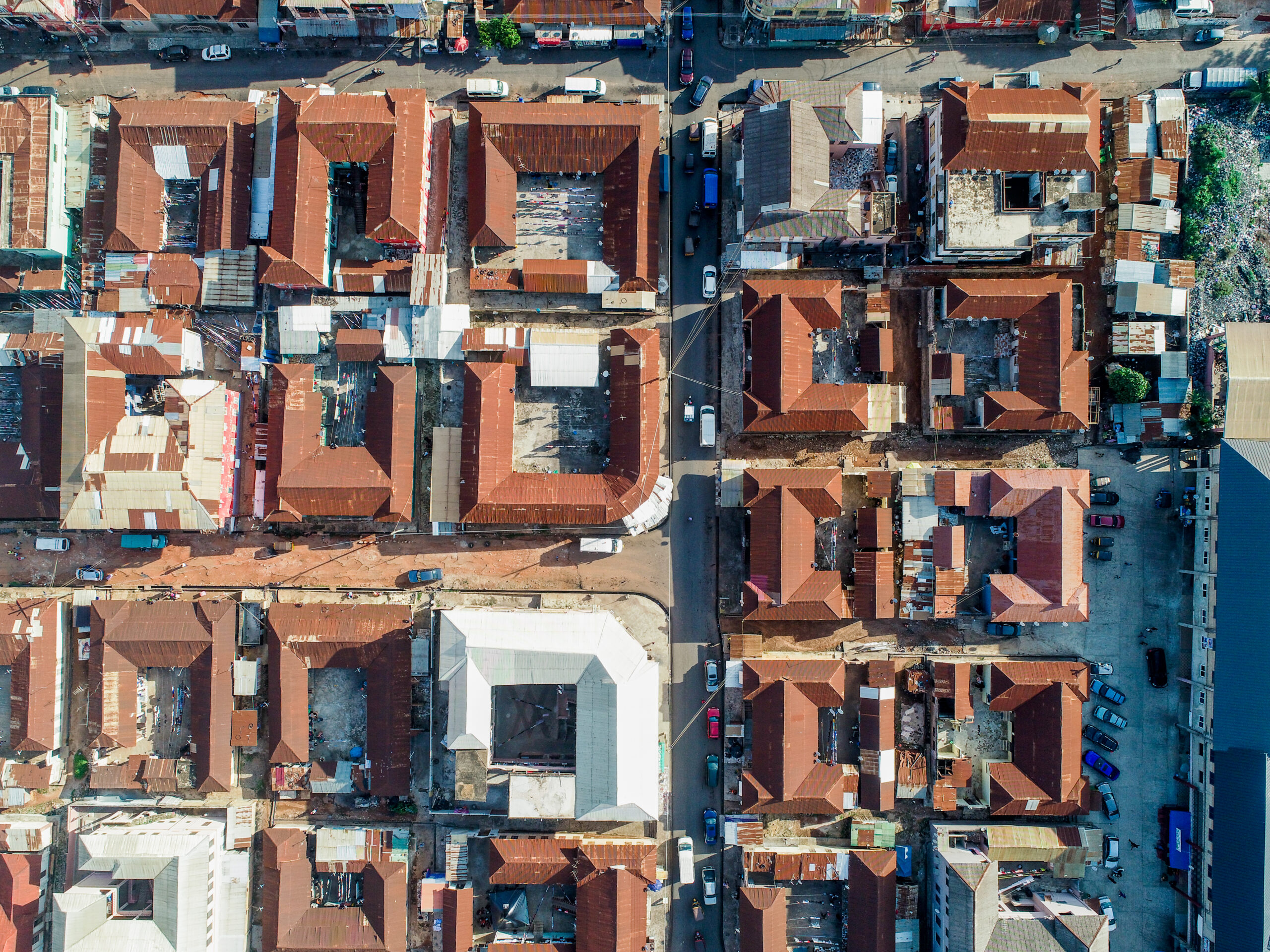
Culturally Inclusive Inter-Generational Sustainable Home
THE GREEN CREW
Ivana Tracey Frimpong, Isaac Egyir Kwofie, Wilda Birago Amoah
Supervised By: Dr. Ing. Alexander Boakye Marful
Top Level Key Words:
Sustainable homes, Future of Housing, Circularity, Healthy Spaces, Inclusive Design, Scaling Science
Throughout history, humanity thrived under the harmonious embrace of daylight, the enchantment of fire, and the soothing darkness of night. Yet, the modern era has ushered us into enclosed spaces, where we now spend a staggering 90% of our precious time. Within these artificial realms, the delicate equilibrium between radiant days and tranquil nights has been shattered. However, hope glimmers on the horizon. By infusing spatial design with optimized indoor parameters and techniques, we can reignite the dormant balance within, ushering forth a renaissance of productivity and restful slumber. By embracing the transformative potential of architecture and design, we can unlock a new chapter in our journey towards a revitalized life!
Unlock the secret to reclaiming our innate connection with the physical environment and revitalizing our well-being!
Understanding the Challenge
Outlining the Problem
Since the industrial revolution, the burning of fossil fuels on a large scale for energy production and manufacturing has led to an increase in the concentration of CO₂ in the atmosphere. This rise in CO₂ levels is contributing to the challenges of global warming. Over the past few decades, nations worldwide have convened multiple times to address these issues, with one significant meeting being the COP 21 in Paris in 2015. The Paris Agreement was established as a result of this meeting, with participating nations pledging to reduce their carbon emissions and limit global warming to 1.5 °C. Achieving this goal requires substantial reductions in emissions.
The VELUX Challenge has inspired new ideas on how to create integrated inclusive solutions in our future homes that enable us to obtain optimal indoor environment by looking at feasible, low impact ideas, services, tools, mindsets, actions, or initiatives that support the designing and building of inclusive and healthy indoor environments.
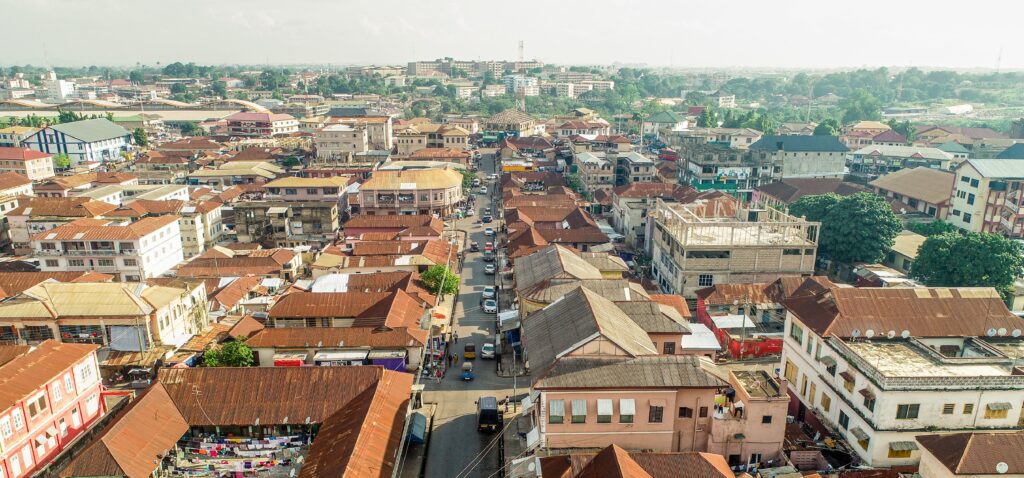
Defining the Problem:
In recent times the concept of sustainability has been a pressing issue, spearing innovations in aspects of society, the environment and economics. With the challenge of designing a sustainable home for the future, the approach focused on three major concepts: Circularity, Inclusive Design and Healthy Spaces. The idea was to ensure that the product of the challenge focused not only on people but also the planet. Under these themes, issues were dissected further into various components:
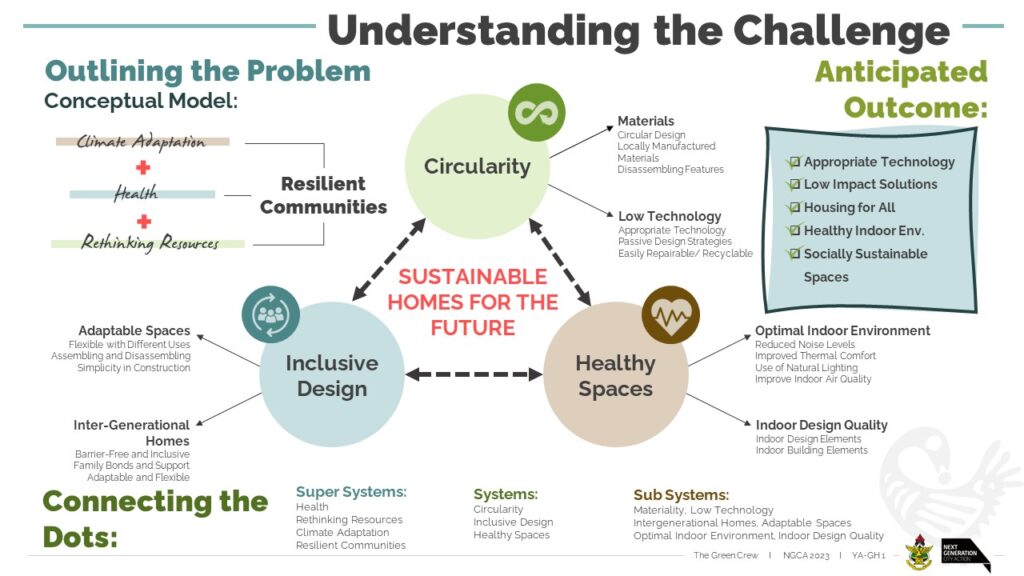
Healthy Spaces
Circularity
Inclusive Design
Optimal Indoor Environment
Our healthy spaces encompassed the use of parameters that ensured optimal indoor environments. This included reducing noise levels by using materials with acoustic properties, improving thermal comfort by analysing our prototype within the Ghanaian climate, utilising building configurations that maximised the use of daylight, and improving indoor air quality by encouraging natural ventilation and cross-ventilation and reducing humidity.
Indoor Design Quality
Our definition of design quality comprised of two components. The first was the indoor building elements including walls, floors, ceiling and furniture. The second aspect included the indoor design elements such as colour and texture, ensuring that sensory provisions were made for both the elderly and children.
To truly enhance the health and well-being of individuals in indoor spaces, a transformative approach to building design was essential. By optimizing crucial elements such as lighting, materials, ventilation, green spaces, and overall coherence, our prototype can become a reliable supporter in promoting holistic mental and physical wellness.
To truly enhance the health and well-being of individuals in indoor spaces, a transformative approach to building design was essential. By optimizing crucial elements such as lighting, materials, ventilation, green spaces, and overall coherence, our prototype can become a reliable supporter in promoting holistic mental and physical wellness.
Approaching the Challenge
Our Methodology
In approaching the challenge, we delved deep within our context to find problems and appropriate solutions that would be relevant to the Ghanaian community, with opportunities to expand to other societies. This led us to exploring the compound house to identify the current challenges present. From our research, it was evident that the compound house fosters strong familial ties, however, the modern influences of urbanisation among many other factors have led to shifts in the traditions.
According to Asante et al. (2015), Individualism, Westernization, Weakening of Familial Ties and General Stigmadiscourage the youth from adopting the compound house as a means of shelter unless they are forced to by circumstances. This leads to a breakdown of the functions of the traditional compound house. Nonetheless, cultural identity, urbanization and globalization, social status, practical considerations and family cohesion are all influences on housing choices today. However, inhabitants adapt housing choices to incorporate modern designs and amenities while retaining elements of cultural heritage.
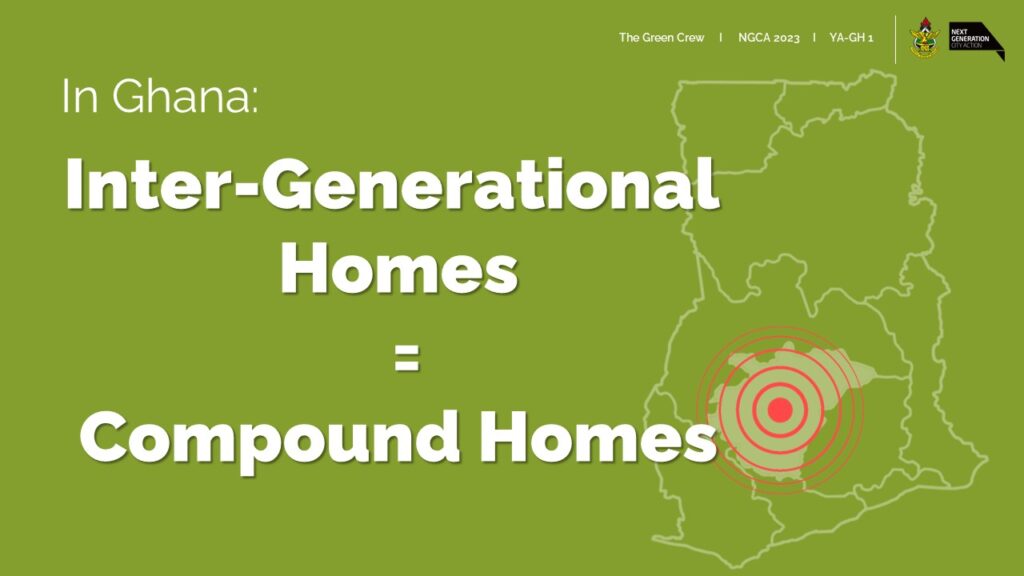
Key Features of the Compound House
The typical compound house is typically rectilinear and covers a 100m2 area. It has an internal courtyard and promotes communal living through its configuration and layout. It is typically has numerous rooms and shared facilities with its structure made of atakpame, cement and sometimes reinforced concrete blocks. The typical room occupancy is 4 to 6 members per household who all may stay within a single room.
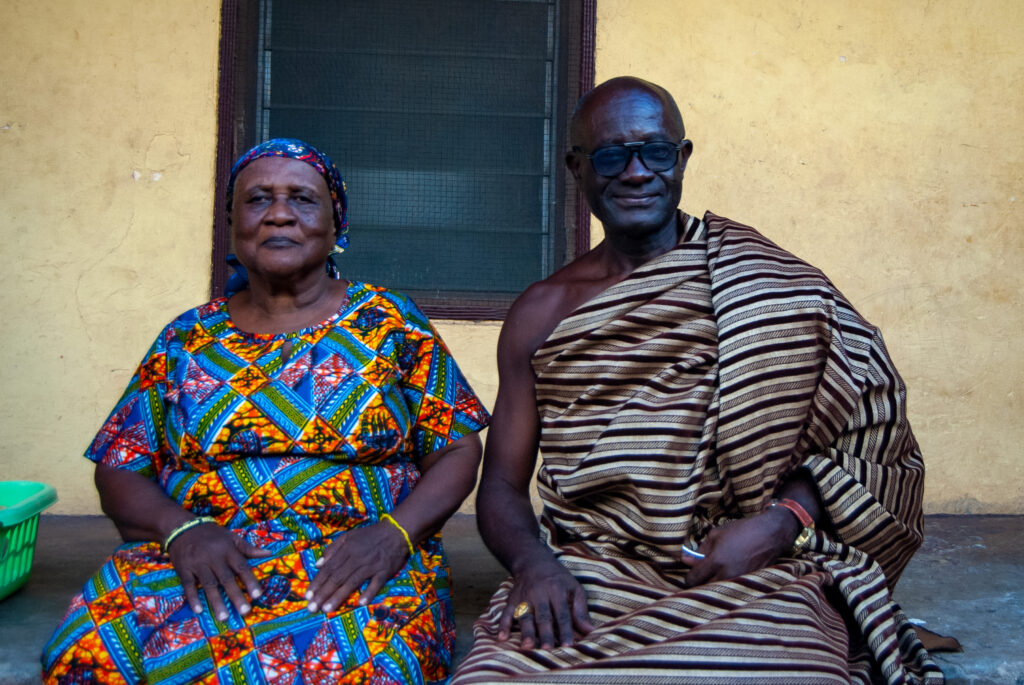
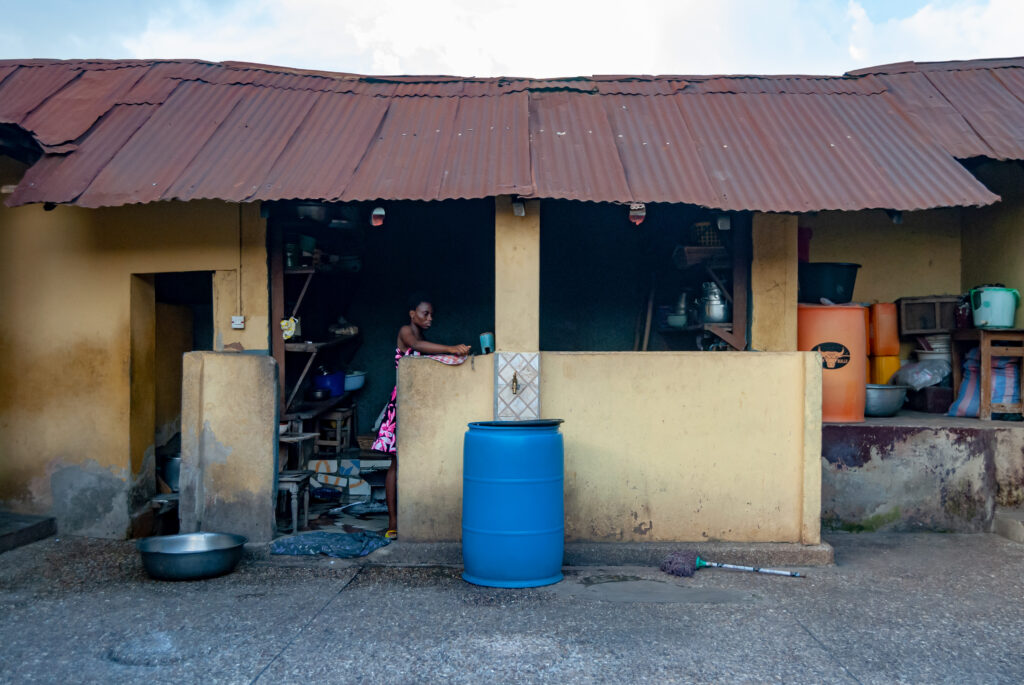
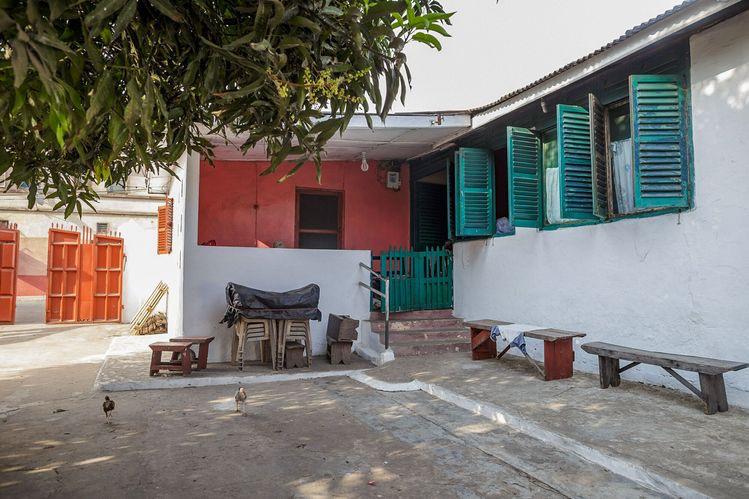
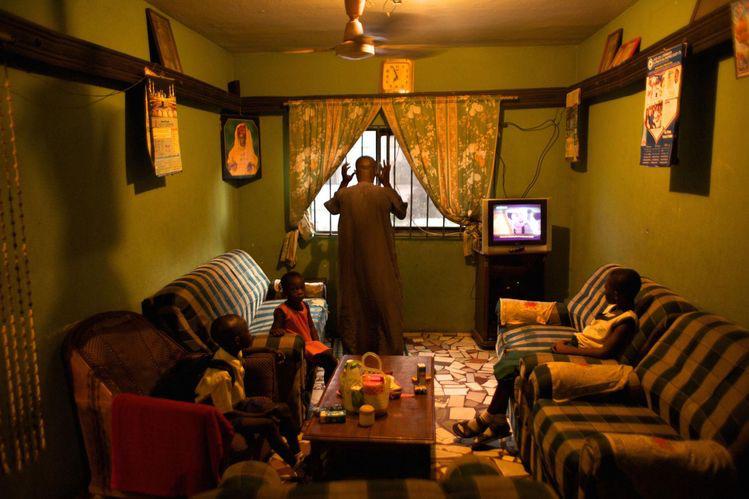
As can be observed from the images above, the internal court is where a lot of social activities take place, including children playing, cooking, drying of clothes, conversations with others, etc. It connects all the households and create a common area where all individuals may gather and interact. We took a look at a typical compound house and found two typologies as documented by Manful (2010). These have been presented below.
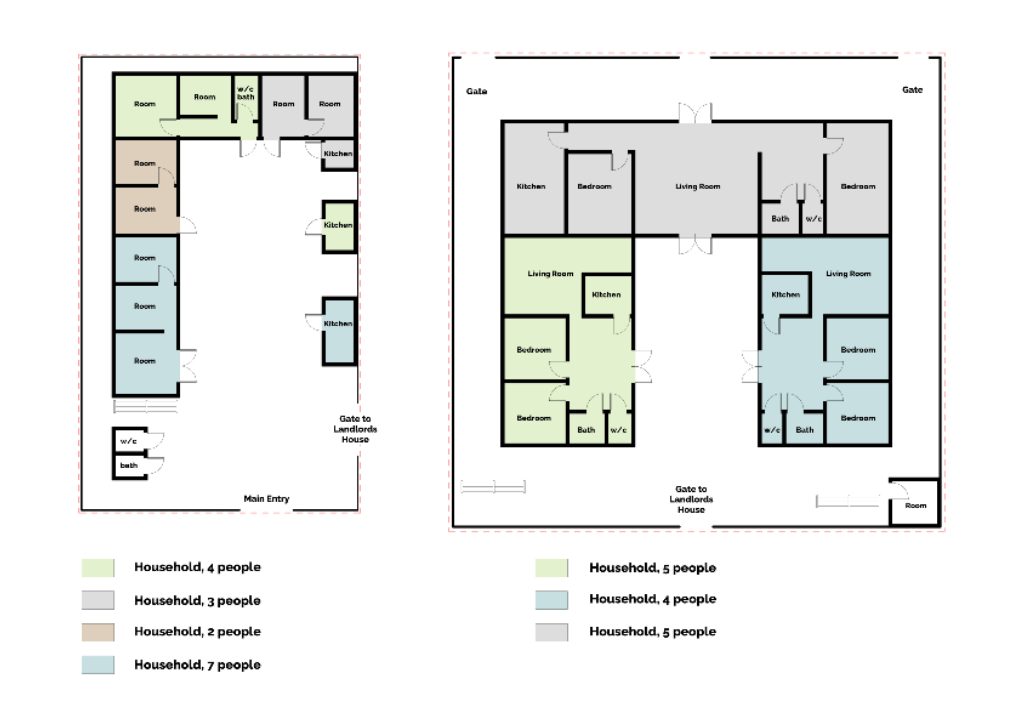
Challenges with the Compound House
Apart from the disruption of the traditional family system largely due to urbanization, those who continue to reside within the compound house continue to stay there mainly due to financial constraints. According to these individuals, issues pertaining to privacy, excessive noise and disturbances, the influence of western culture, emphasis on individuality, and the need for maintenance have all played a role in weakening familial connections. Moreover, these factors have created a general societal stigma that dissuades people from considering compound houses as a viable housing option unless they are compelled by circumstances.
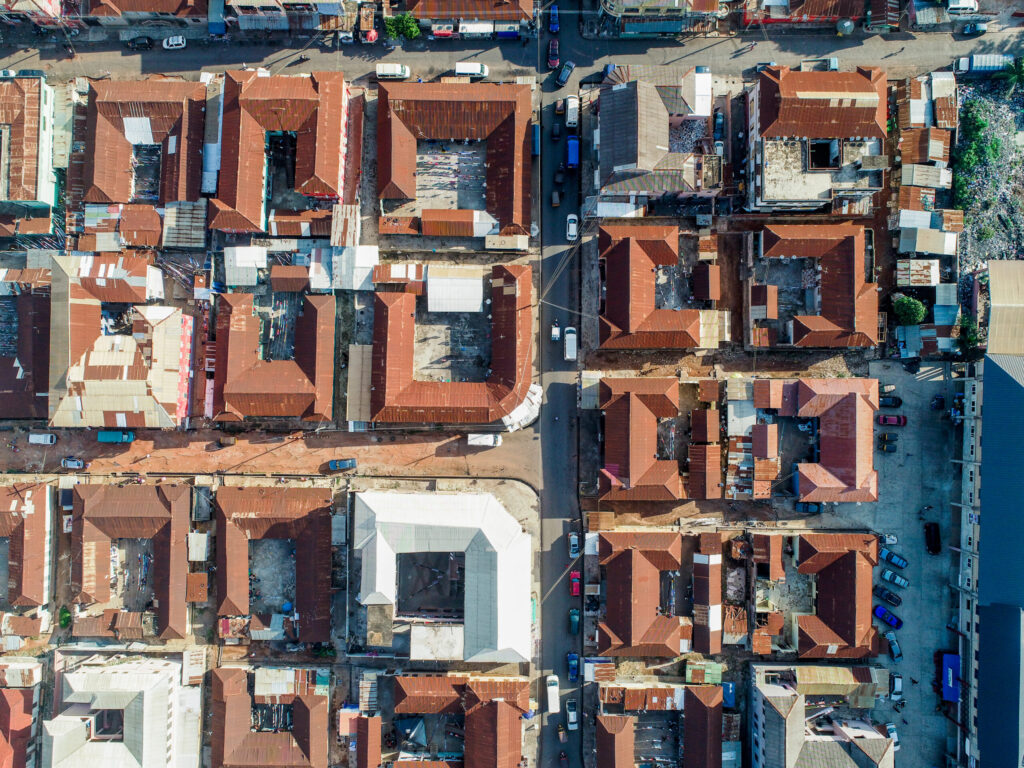
It is worth noting that while these challenges exist, they can often be managed effectively through open communication, mutual respect, and a shared understanding of the rules and responsibilities within the compound. Although a majority associate a compound house with its problems like noise, disturbance, privacy issues amongst others, many people find living in a compound house to be a positive experience that fosters a sense of community and shared support and this is what our solution seeks to amplify!
Tackling the Challenge
Abusua Fie
Project Background:
Our project is titled ABUSUA FIE which simply translates as “Family House”. Abusua Fie seeks to amplify the positives of the compound house while diminishing the existent challenges. This has been achieved by adopting a design concept that encourages selective participation by providing a court within a court concept. Additionally, by integrating sustainability practices and climate adaptation strategies, Abusua Fie not only reduces our ecological footprint but also withstands the challenges of a changing climate. Thus contributing to a culturally inclusive sustainable home.
Design Objectives:
From our in-depth research, there were a few observations that informed out design choices.
- To meticulously cater to the needs of the young, old, able and assisted by providing spaces for all
- To provide incremental units allowing for growing families and households
- To ensure possibilities of rentable units, adaptable spaces and the use of appropriate technology
- To promote passive design and security through communal living and social support
- To allow for selective participation and engagement

Design Concept:
The concept for Abusua Fie is “Congregation through Separation”. We took a typical compound home and segmented it into various parts. We then subtracted alternative units to come up with new separated forms. These forms were then re-configured to create a court within it while still allowing for good airflow and lighting. The core of the blocks were then taken out to create the “court within a court” concept.
The modules were then arranged on a selected site to form a community with a playground in the middle. Commercial zones were placed on the outskirts allowing for individuals within the compound house to continue trading to contribute to the day to day expenses. The concept of modular housing was a vital component of the Abusua Fie due to the culture associated with the compound house and the flexibility of modular homes. The choice of this approach also allows for the neighbourhoods to be replicated easily within any urban or rural setting.
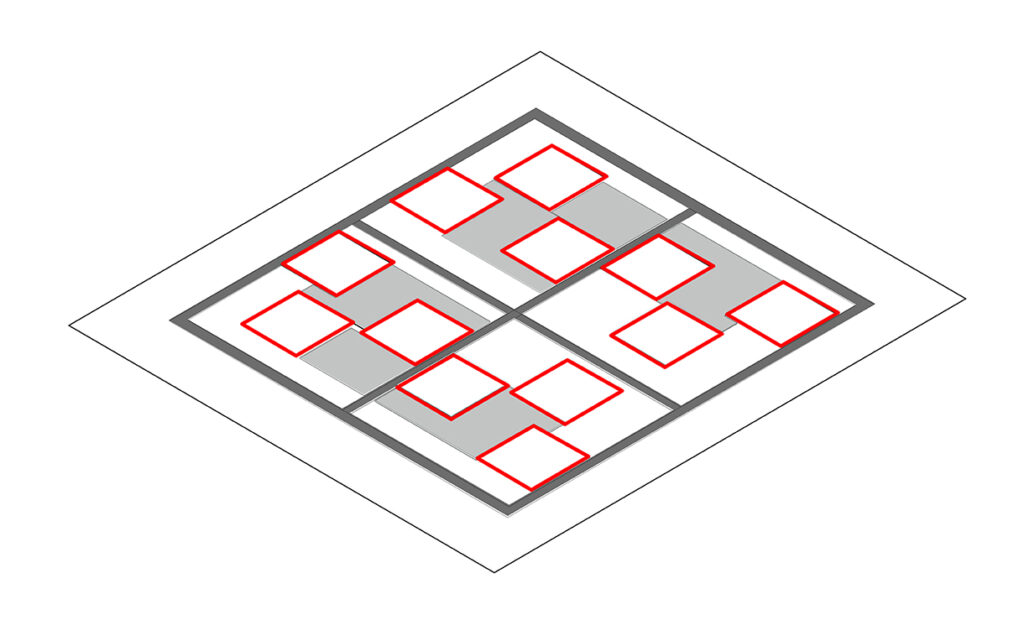
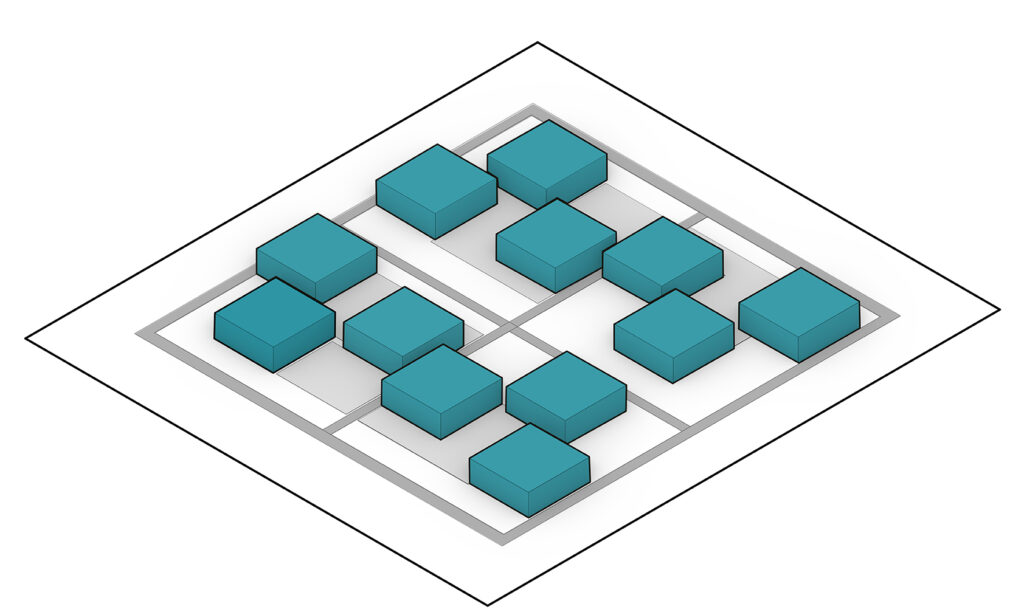
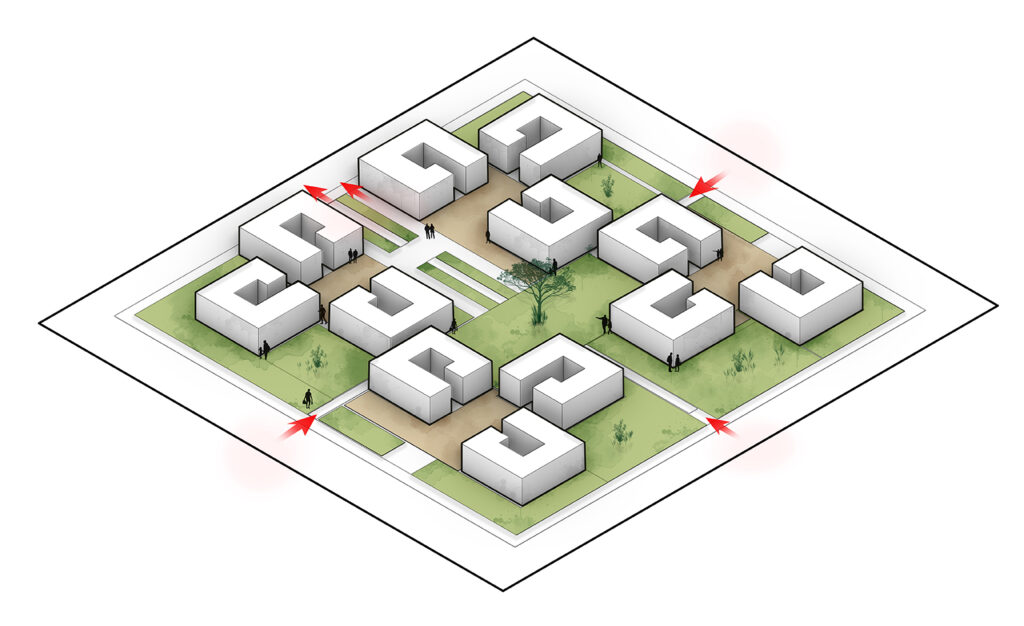
As a pilot project, the prototype focuses on the people within the Ashanti Region of Ghana. To ensure that the project was inclusive, we looked at the potential family pairings with varying degrees of mobility challenges. Additionally, we explored the possibilities of multiple configurations of the compound home by adapting modular housing concepts. We looked at four basic household spaces which included the living area, the bedroom, the kitchen and the bathroom.
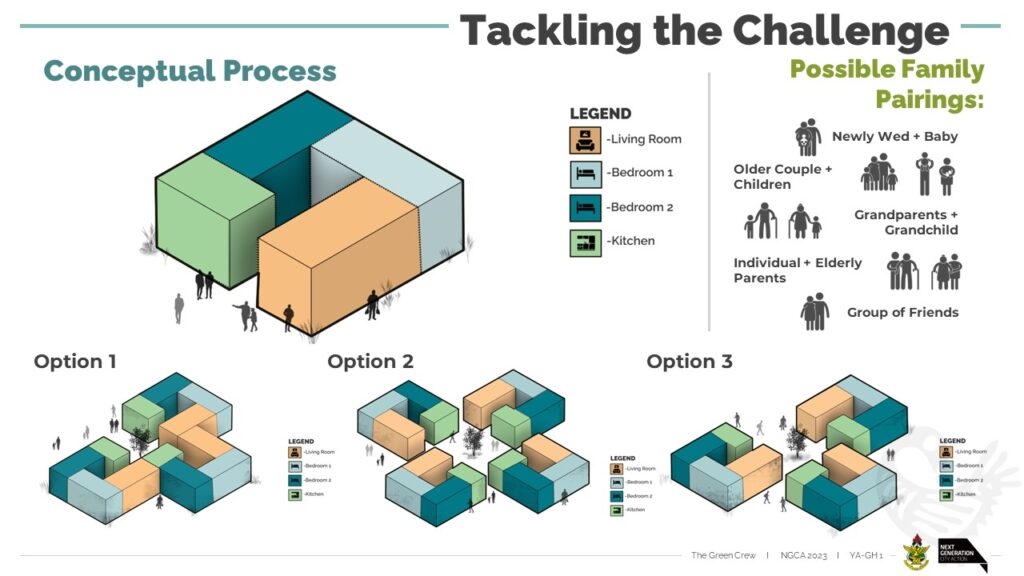
Addressing the Challenge
The Outcome
The Abusua Fie prototype consists of a single unit with a shared living and dining area, shared bathroom and kitchen and two (2) bedrooms. The external walls of the unit is made of rammed earth, with the internal partitions made of interlocking blocks. All windows are louvres blades allowing for natural lighting and ventilation. Passive design strategies were amplified in the prototype through the provision of the courtyard which promotes cross-ventilation, selection of thermally appropriate materials, the inclusion of honeycomb walls and the provision of shading devices.
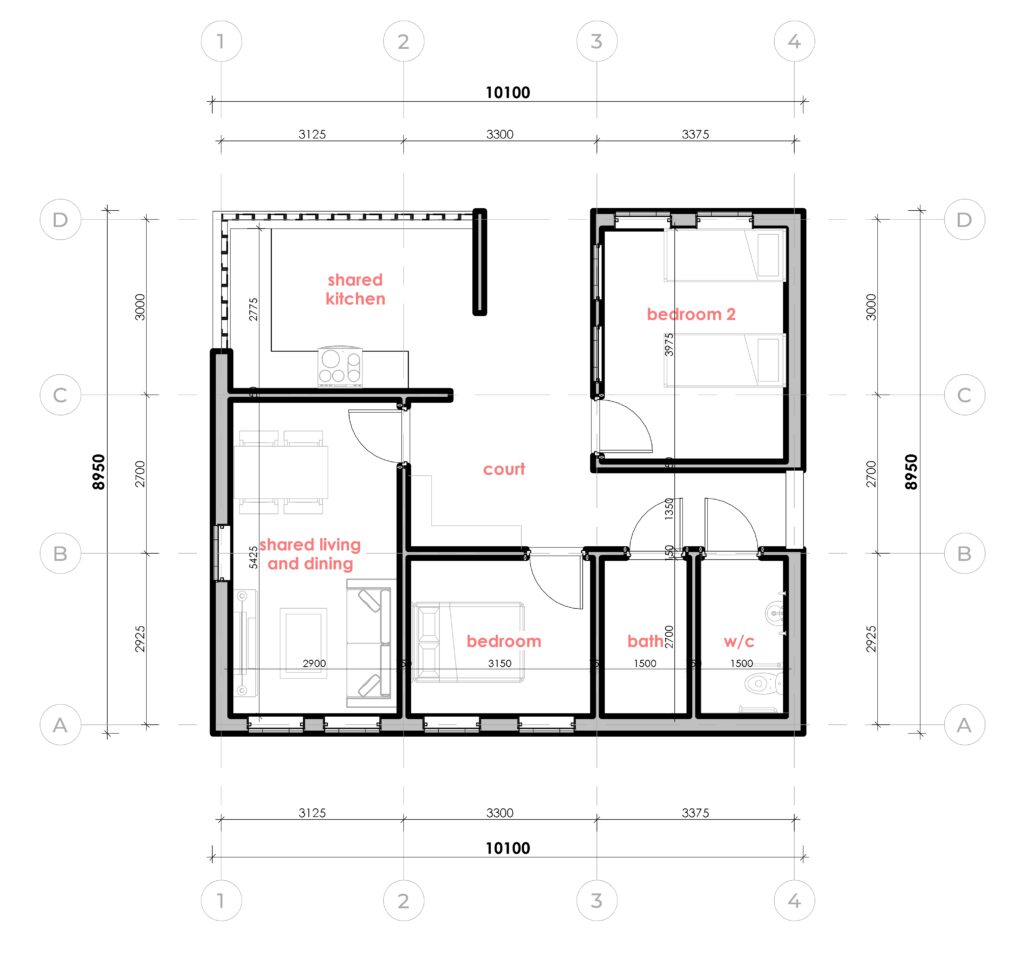
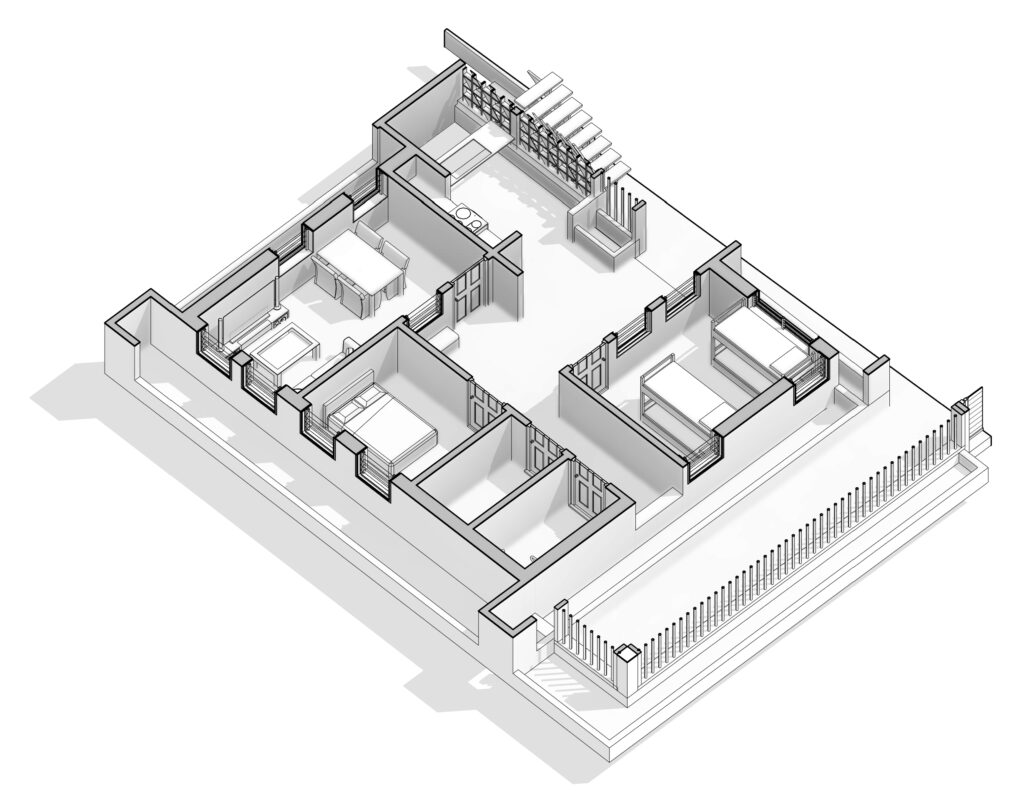
The prototype can be scaled up to form a bigger compound home with a common court. The internal courtyard can be utilised for drying of clothes, cooking, washing of clothes, play area for children, among other cultural activities. It also works as a passive form of security as all the blocks face the central shared courtyard. By configuring the prototype as it is, we transform the definition of the compound home and achieve the concept of selected participation which promotes the notion of privacy.

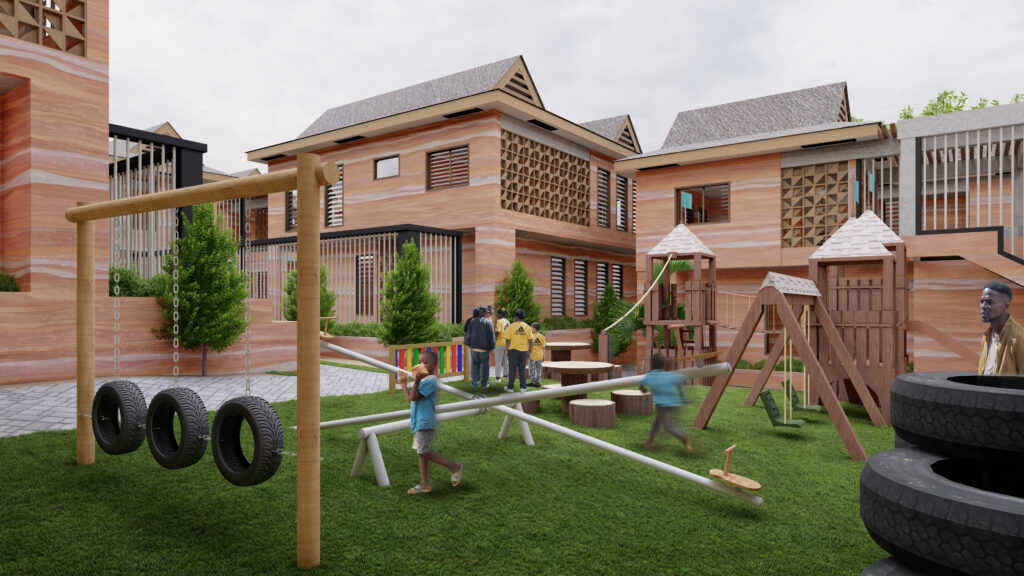
The singular unit is additionally scaled up again to include a second floor to help densify the area due to rising land prices. Our prototype provides accommodation for at least 24 individuals. This is against the 16 and 18 individuals as documented in Manfuls (2010) study, which is typical for most courtyard homes in Ghana.
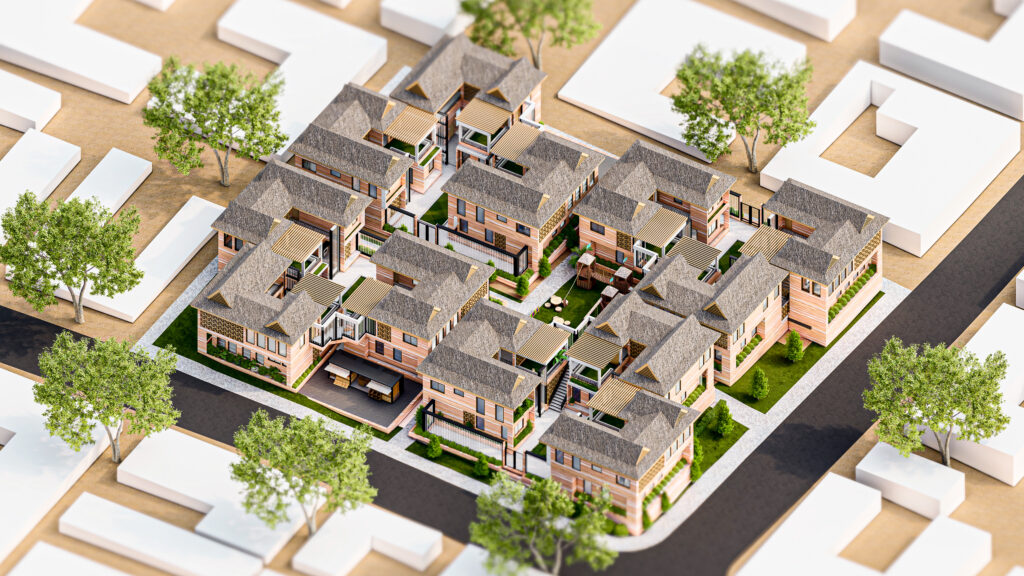
Additionally, we have improved the micro-climate by introducing garden terraces and backyard gardens and selecting appropriate materials and technology. This encourages individuals within the home especially the elderly to still have activities to engage in throughout the day. The inclusion of the play area for children using upcycled items as well as the provision of commercial zones within the enclave demonstrate our wholistic approach to the challenge.
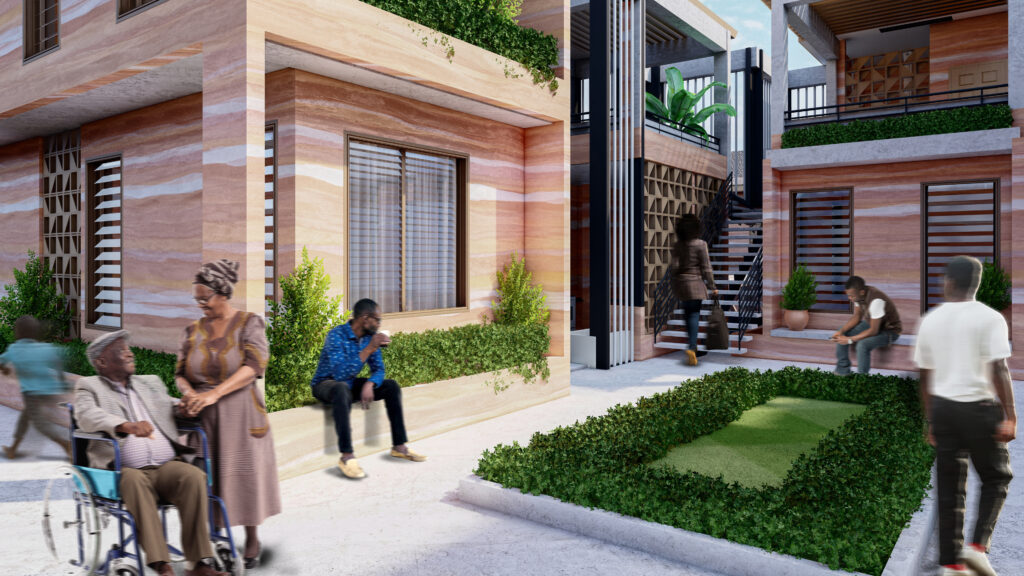
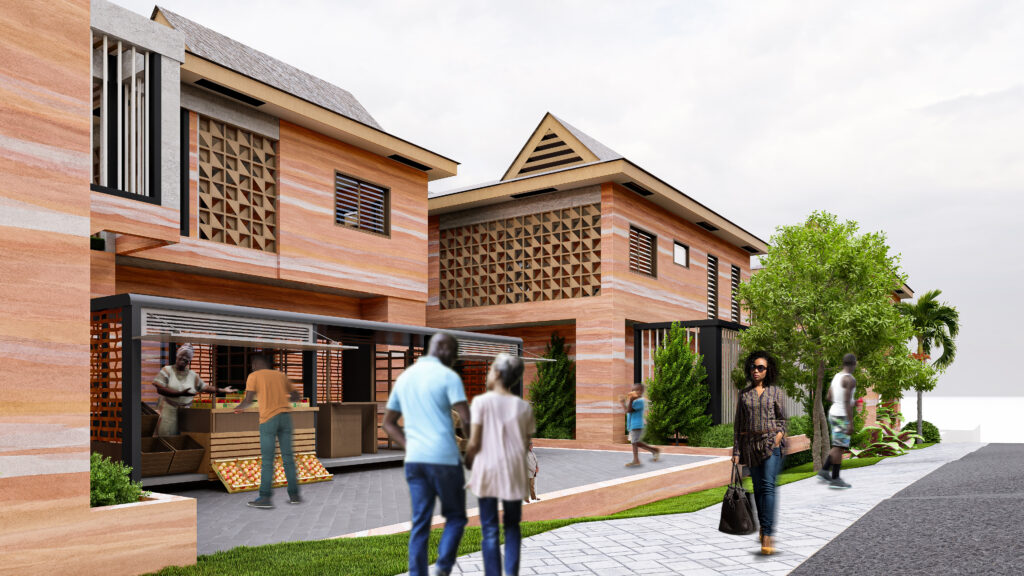
Inclusivity was also a major aspect of our outcome, not only in terms of persons with disability but in terms of gender, background, variable circumstances such as pregnancy, etc. This notion pushed us to design flexible and adaptable space that could have alternative uses. This included the use of flexible furniture as well as materials.
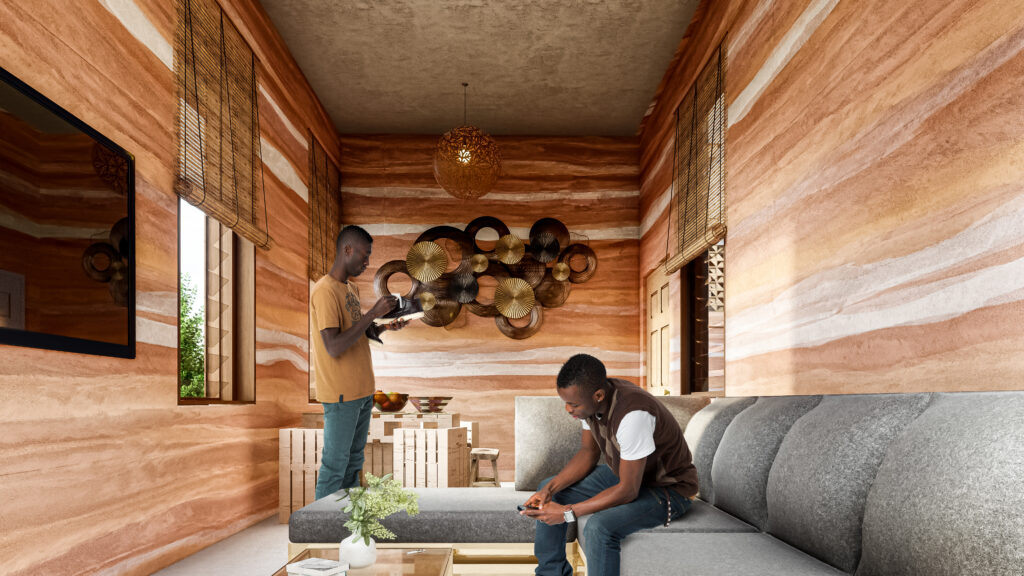
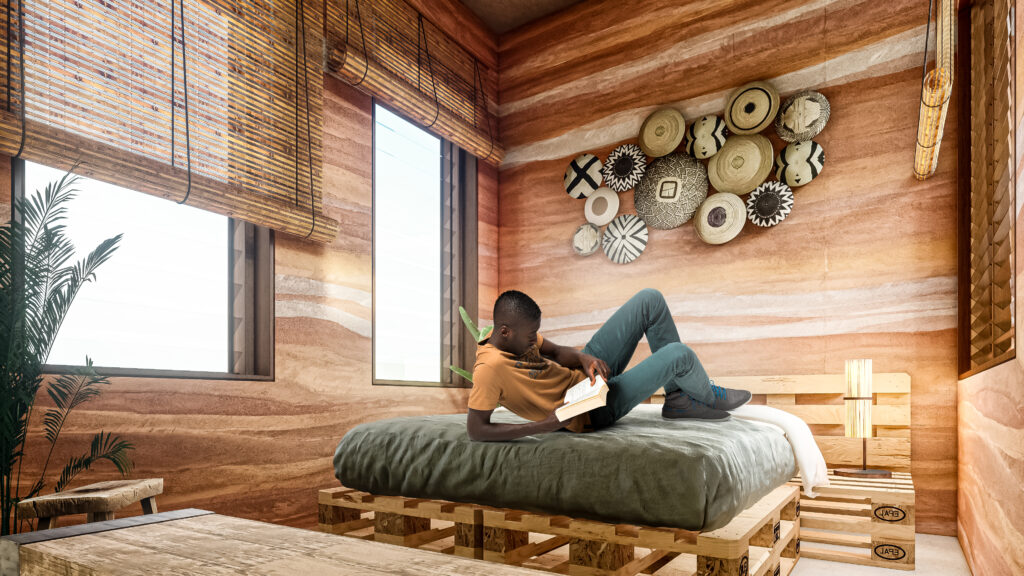
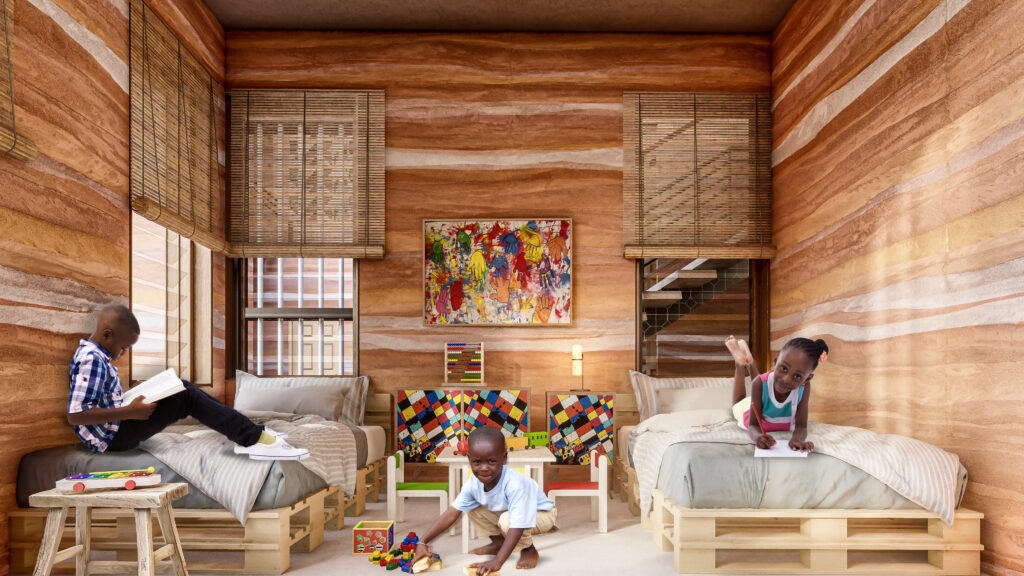
Challenging the Challenge
Innovative Aspects of Our Solution – Theory of Scaling Science
Scaling Science Scaling Deep – Up – Out
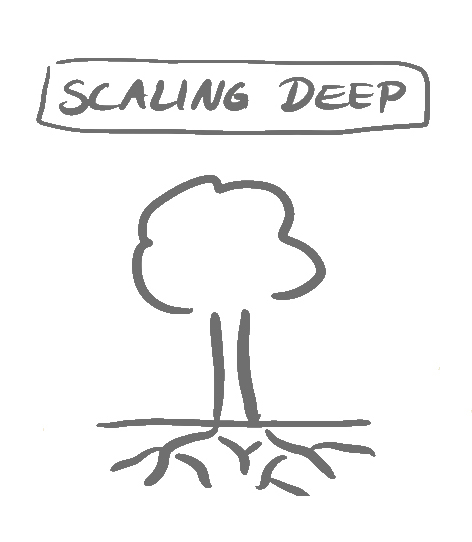
Scaling Deep
By delving deeper into scaling impacts, we were able to tackle the prototype’s quality and essence, enabling it to flourish in accordance with the preferences and desires of its users.
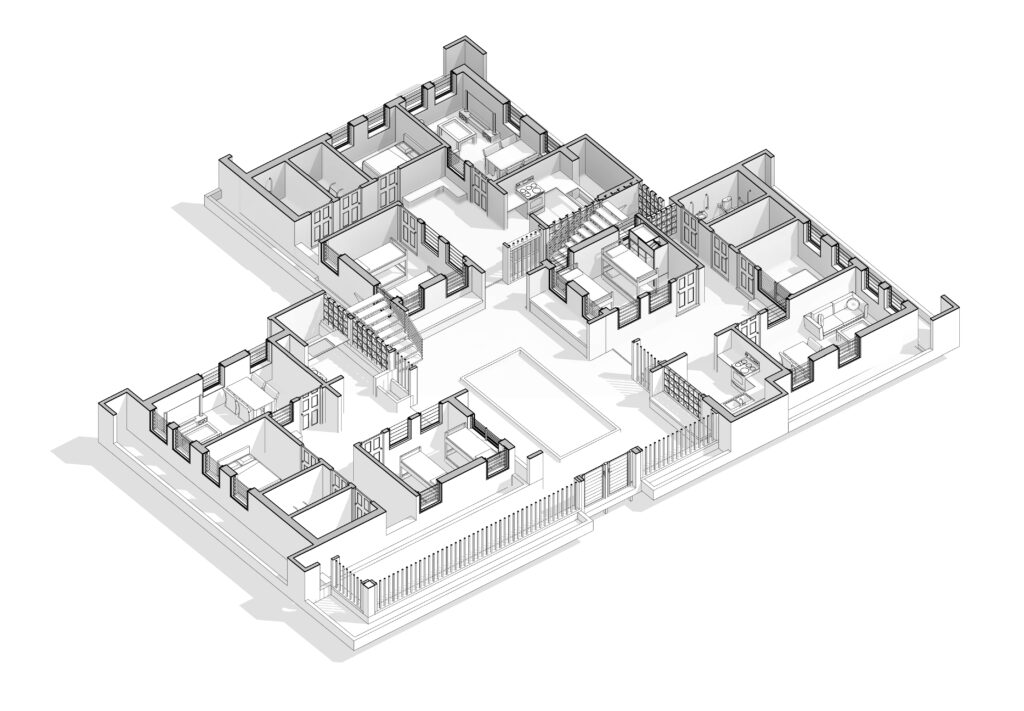
By addressing issues pertaining to privacy, noise, and other vices of communal living, the abusua fie prototype provides a template for other regions globally interested in this sustainable approach to housing. Through the elevation of the prototype’s adaptability, we are able to span from local to national and even international levels (including the Mediterranean and European climates).
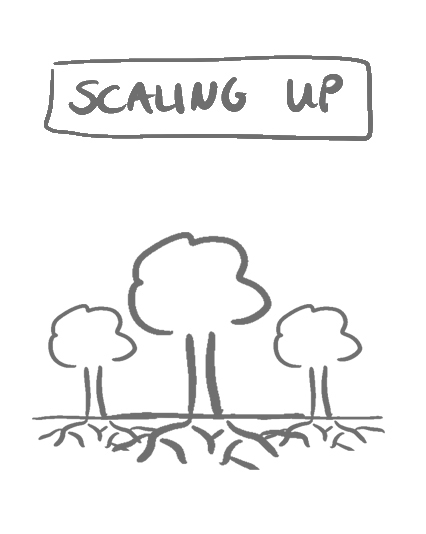
Scaling Up
The Abusua Fie initiative aims to establish additional ventures, not only by expansion vertically but also by fostering the replication of the same model or its variations at various levels across Ghana.
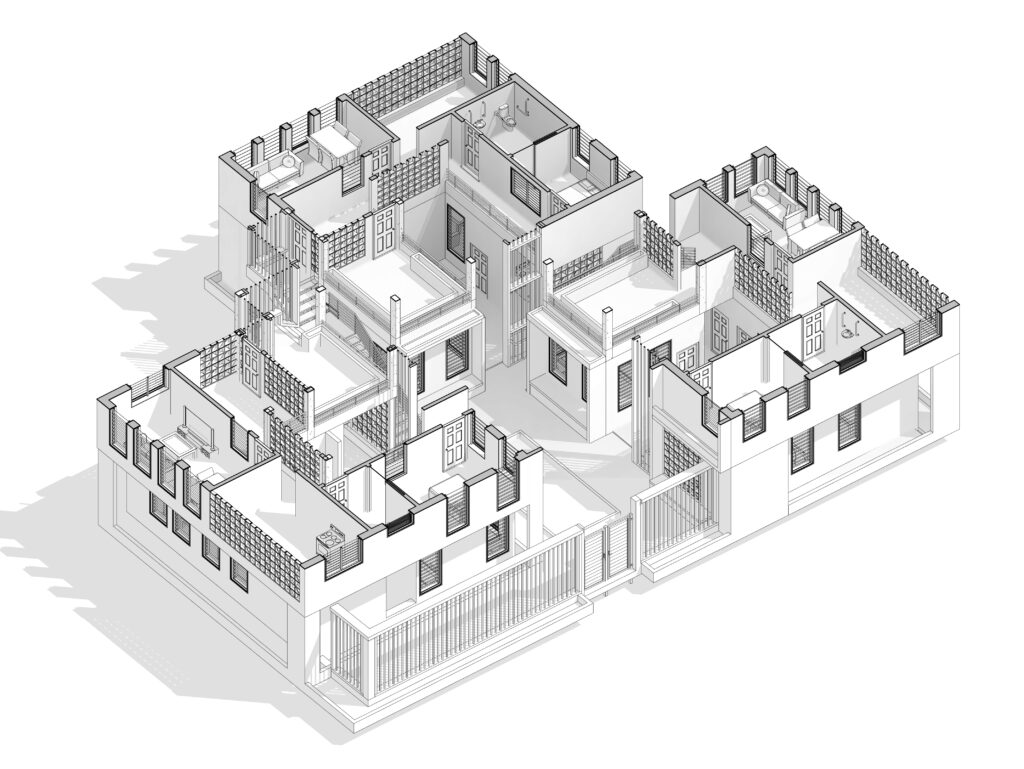
It is important to note that under the theory of scaling science, the fact that the product is good and suits a context does not mean it has to multiply, that is why we first scale deep before we scale up and then scale out.
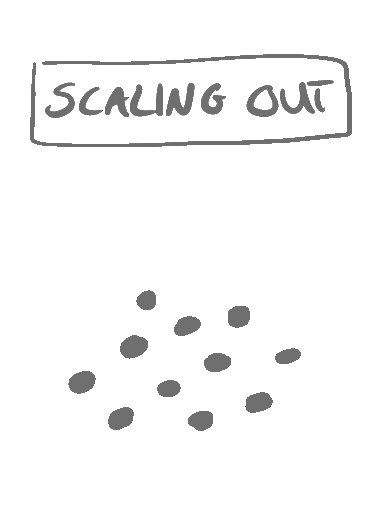
Scaling Out
In scaling out, we amplify all the positive components in the scaling up step usin the theory of scaling science. By doing this, we are able to export feasible concepts to other countries and cultures not only within the tropics, but in all regions of the globe.
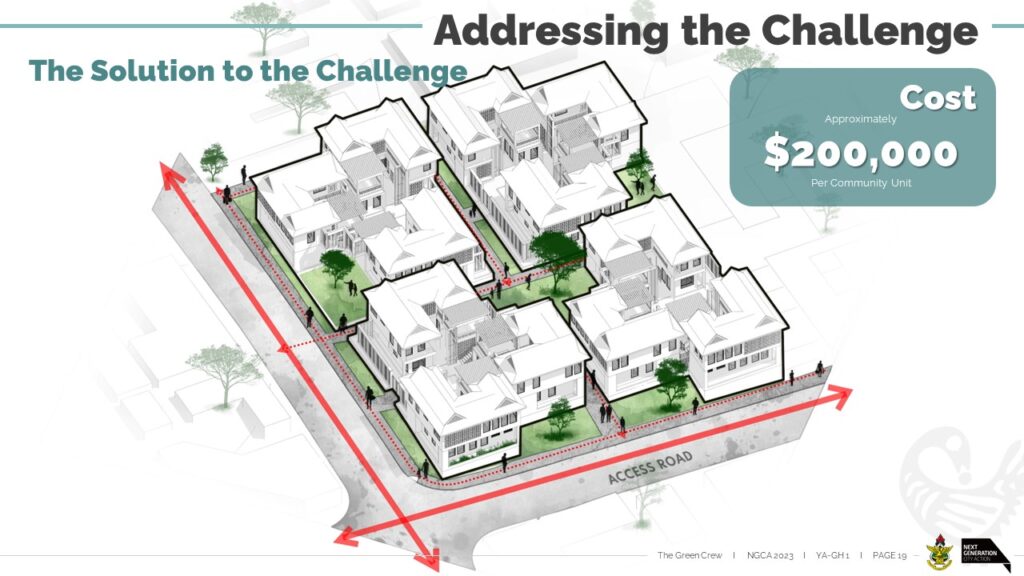
Additionally due to our choice of mud as the primary construction material, it allows for the home to adjust to all climates. Alternatively, materials may be substituted in areas where the suitability of mud as a primary resource may not be feasible.
Project Impact
As an architect and urban planner, it is essential to explore innovative ways of creating spaces that prioritize the well-being of individuals. Building design plays a significant role in shaping the health, social, economic, and environmental aspects of our lives. We delve into the numerous benefits of the Abusua Fie initiative by looking specifically at four aspects of the projects impact.
Social Impact
Creating socially inclusive spaces fosters a sense of community and connectivity and plays a key role in terms of impact. It was imperative that Abusua Fie did not retract from the current societal dynamics, but instead enhanced virtues leading to a future of transformation without destruction. Some of the social impacts identified have thus been discussed below.
- Providing Spaces for All
Incorporating universal design principles ensures that spaces are accessible and adaptable to people of all ages, abilities, and mobility levels. This promotes inclusivity, enabling individuals to live independently and actively engage with their surroundings. - Positive Community Interactions
Thoughtfully designed communal areas encourage social interactions and gatherings facilitating the formation of strong social and familial bonds, leading to a vibrant community life and improved mental and physical well-being.
Environmental Impact
Choosing environmentally friendly building materials and practices positively impact the planet. For the team developing Abusua Fie, it was important to not only look at the material but also its constructability and feasibility of use.
- Low Environmental Impact
Rammed earth is an environmentally friendly material as it is abundantly available, requires minimal energy for production, and has low embodied carbon. Its use reduces reliance on resource-intensive materials such as concrete or steel. - Reduced Carbon Footprint
Incorporating rammed earth and energy-efficient design principles significantly reduces the carbon footprint of the building. This promotes sustainable development and mitigates the impact of climate change. - Promotion of Healthy Indoor Environments
Abusua Fie maximizes natural ventilation and daylighting, minimizing the need for artificial lighting and mechanical ventilation. This decreases energy consumption and reliance on non-renewable resources and promotes energy conservation.
Economic Impact
Optimal indoor environments and sustainable building practices can have positive economic implications due to its direct relation to resources. Based on this, the Abusua Fie initiative has the following economic impacts:
- Increased Energy Efficiency
Since Abusua Fie is built with thick rammed earth walls and louvred windows, it reduces energy consumption in terms of mechanical ventilation and lighting. This results in lower energy bills leading to long-term cost savings for occupants (www.energycom.gov.gh/files/ENERGY%20STATISTICS-2020.pdf) - Improved Durability and Low Maintenance
Rammed earth structures have been shown to have excellent durability and require minimal maintenance over time, as it is an upgraded form of traditional earth construction. This lowers repair and renovation costs, making the living space more economically sustainable.
Cultural Impact
Culture as a fourth pillar of sustainability is a concept that is being explored to ensure that innovations within society does not displace the key component of what makes a place unique. Consequently, we looked at how our project can impact in this dimension.
- Preservation of Cultural Traditions
Abusua Fie will serve as a means to preserve and uphold cultural traditions by encouraging families or extended family members to live together helping to maintain close ties, pass down cultural values, and ensure the continuity of customs, rituals, and practices from one generation to the next - Encouraging Cultural Diversity and Exchange
The Abusua Fie Initiative can be inhabited by individuals from different cultural backgrounds or extended families with diverse traditions based on our possible pairings of individuals. This multicultural environment offers opportunities for cultural exchange, learning, and appreciation, and the broadening of perspectives, fostering tolerance, and enriching the overall cultural experience of the residents. - Promotion of Inter-Generational Living
The concept of inter-generational homes allows older members of the family to impart knowledge, wisdom, and cultural heritage to younger generations. Additionally, due to the ageing global population, issues with isolation and loneliness that often come with old age can be curtailed. Additionally, it also facilitates the sharing of responsibilities and resources among family members and provides help to all persons regardless of age, gender, etc..
Project Financials
Possible Key Partners
- Ashtown, Ashanti Region- Ghana
- KNUST
- Traditional Authorities
- Government of Ghana – Ministry of Tourism
- Orthner and Orthner Architects
- Hive Earth
- Foreign Investors and Partners (i.e. Universities, Sustainability institution, etc )
Key Resources
- Earth Technology
- Appropriate Technology
- Local Labour and Technical Skills
- Passive Design Strategies
Value Propositions
- Provides a healthy space
- Contributes to reducing the Housing Deficit which stands at 1.8 Million Housing Units
- Relationships
Customer Relationships
- Persons With Disabilities
- Elderly
- Youth
- Children
- All Persons
Channels
- Social Media
- The community
- User Feedbacks and Evaluation
Revenue Streams
- Ministry of Works and Housing . (Rental Assistance Scheme )
- International Investors
- National Rental Assistance Scheme(NRAS)
- Home Ownership Fund
- Cheap building materials
- African Development Bank and GCF Partnership
Eco-Social Benefits
- Enhanced Sense of Community
- Increased Socialization
- Privacy and Boundaries
- Sustainable Materials
- Energy Efficiency
- Durability
- Climate Adaptive and Low Maintenance:
Key Activities
- Construction of a Rammed Earth Inspired Compound House
Assessing the Challenge
Evaluation of Our Challenge
Healthy Spaces
Circularity
Inclusive Design
Abusua Fie focuses on two main aspects when it came to healthy spaces. That is optimal indoor environments and indoor design quality. Particularly the prototype focused on daylighting and natural ventilation, through the use of measures such as louvre blades, honeycomb walls, translucent roofing, cross-ventilation and passive design strategies.
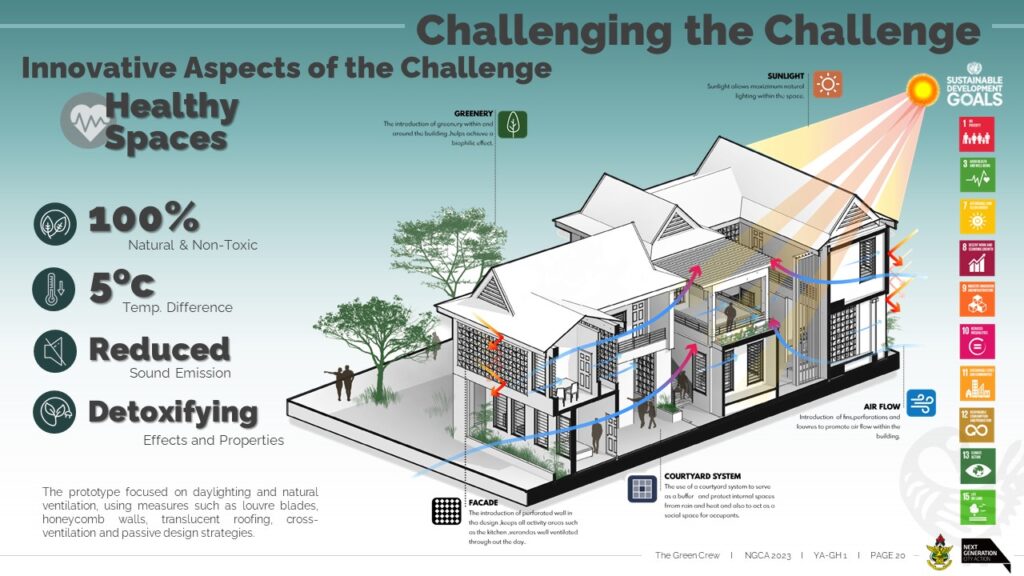
Road Map To Abusua Fie
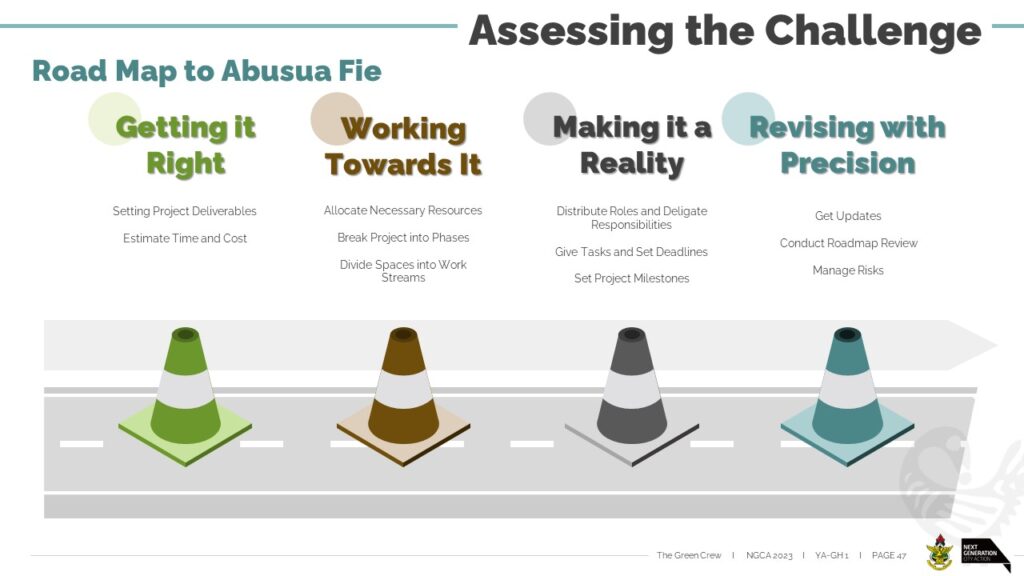
The Product of the Challenge
A Culturally Inclusive Inter-Generational Sustainable Home
Abusua Fie
As we envision the future, there is great potential for progress in the field of health and wellness design. Architects will play a central role in advocating for the collective well-being of society, leading the way towards a harmonious coexistence between humans and their built environments!
The Green Crew
The Team

TEAM LEAD
Kwame Nkrumah University of Science and Technology
PhD Architecture
2nd Semester
Among my interests are Barrier-Free and Inclusive Design, Interior Design, Designing for persons with Dementia and the Aged. I am meticulous with a good work ethic and strengths in timeliness and teamwork.

Kwame Nkrumah University of Science and Technology
PhD Architecture
4th Semester
My interest lies in Circular Economy and interior design. I have experience in Designing and Construction. In addition, I consider myself to be very effective in finding solutions to problems and working in teams.
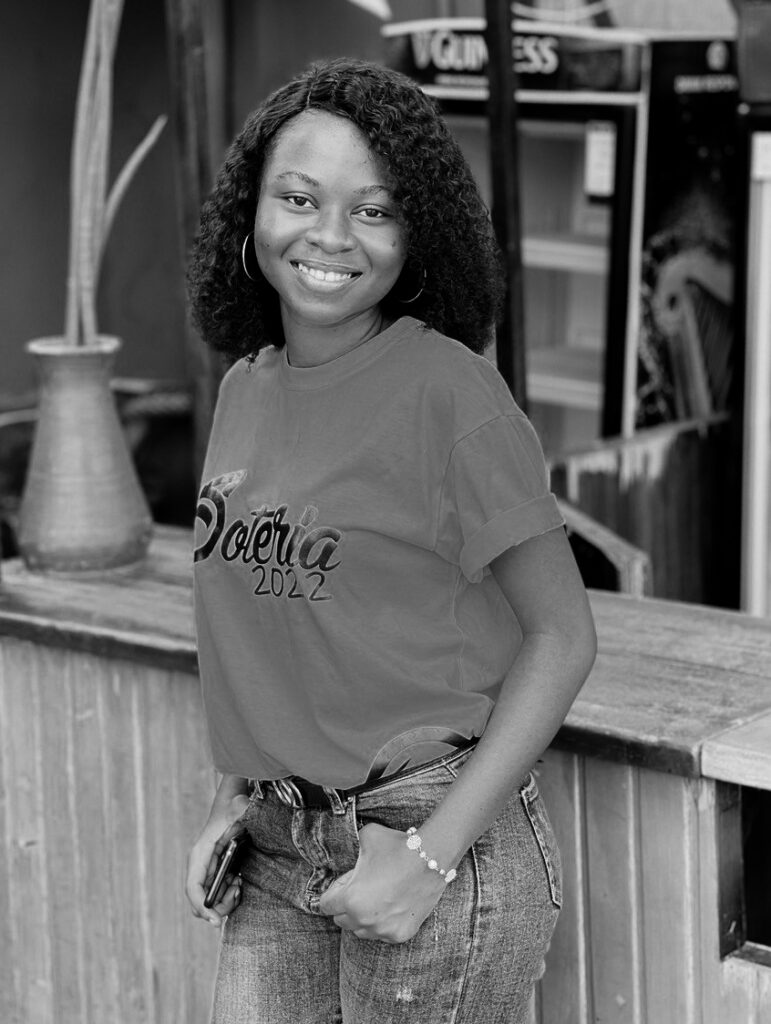
Kwame Nkrumah University of Science and Technology
MSc. Development Planning and Management
2nd Semester
My interest lies in designing and implementing strategies that address issues such as land use, infrastructure, and community development to create vibrant, liveable urban environments to foster sustainability and stimulate economic progress.
